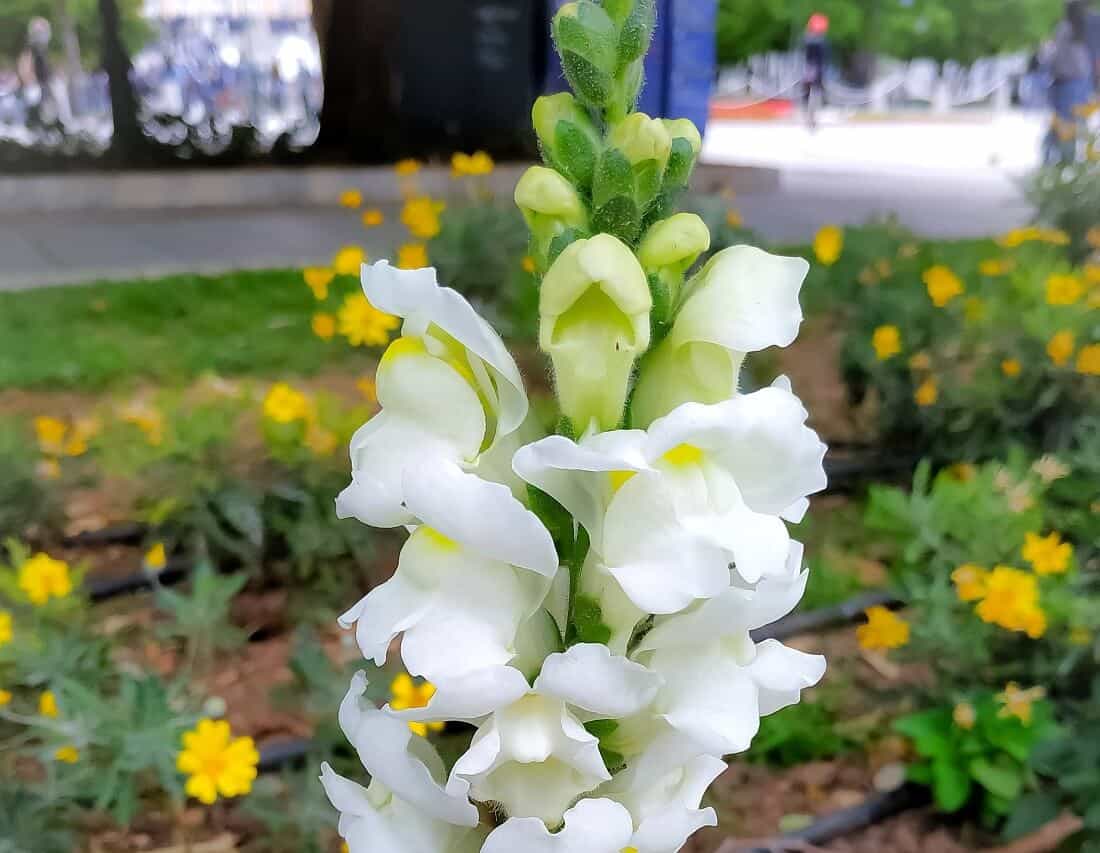Snapdragons (Antirrhinum majus) are tender perennial cut flowers that according to the US Department of Hardiness Zones are only hardy in Zones 8 /9 through 11. This article is about snapdragon care and it explains how to grow and care for snapdragon flowers.
These fragrant flowers grow easily in pots both indoors and outdoors. Moreover, Garden snapdragons also do well in hanging baskets as well as patio containers.
Do you have some old window boxes and are not sure of what to use them for? Well, try growing some snapdragons in them, believe me, you will be amazed at the outcome.
Sounds exciting?
Let’s then look at how to grow and care for snapdragon flowers step by step.
7+ Easy Steps on How to Grow and Care for Snapdragon Flowers

Step 1: Select a suitable potting mix for your snapdragon flowers
Snapdragons thrive best in well-draining and moist soils. If your planting site has poor soil conditions, such as excessive sand or clay, add a few inches of well-aged compost to the topsoil.
This enhances the soil structure and improves drainage such that the soil holds more nutrients and moisture.
Antirrhinum majus grow best at a pH between 5.5–5.8. Higher Ph might lead to iron deficiency.
Thus, you need to first be sure of the Ph level and apply the necessary corrections if need be.
If you need to lower the soil pH (making the soil more acidic), used coffee grounds and vinegar are a good choice especially in containers. But if your garden area is larger, use Sulfur-Coated Urea or Aluminium sulfate/ Iron sulfate for faster results.
On the other hand, if you wish to raise the soil pH (making the soil less acidic), apply a material that contains some form of lime for example ground agricultural limestone.
Step 2: Plant your snapdragons at the right time
Snapdragons prefer cooler temperatures so, start your snapdragons from seed indoors 6-8 weeks before the last frost of the year.
But if you don’t want to start your seeds indoors you can plant them outdoors in late fall for them to come up in early spring.
During the 6-8 weeks, keep the seedlings well-watered and warm, up until they produce leaves. At this point, your seedlings are strong enough for outdoor transplanting.
Alternatively, buy already established snapdragon seedlings from the nursery should you wish to skip the seeding process.
Winter sowing of snapdragons
This is a very common method of starting snapdragons mostly to gardeners in zone 3 or 4. The majority of these gardeners have found it to be one of the best and easiest ways to start your snapdragons from seed.
You can also start your snapdragons from cuttings
In this case, take your cuttings about 6 weeks before the first fall frost. Dip the cuttings in a rooting hormone and sink them in moist, warm soil/ substrate.
In about 2–3 weeks, the cuttings will have already rooted and can hence be transplanted.
To divide your snapdragon roots you have to dig up the entire plant in late summer.
Step 3: Expose your plants to enough sunlight
Keep your snapdragons under the full sun (minimum 6 hours of direct sunlight) to partial shade in spring for them to bloom best.
Once the temperature heats up, they may stop blooming altogether. But placing them in the partial shade while keeping them well watered will help them make it through the summer and will most likely bloom again in fall.
Step 4: Water your snapdragon flowers
Water your snapdragons every week once the roots have been established.
When your snapdragons can't soak up enough water from the environment, they will start to show signs of struggle, for example, wilting. This is due to a lack of turgor as the plant’s cells aren’t getting enough water.
At this point your snapdragons need water as a matter of emergency otherwise, they will die!
There are different methods to water your snapdragons. For your garden grown snapdragons, we recommend that you use drip or overhead irrigation. Should you go for overhead irrigation, it is important to use it up until the plants start to flower.
On the other hand, your potted snapdragons need water daily during hot weather.
To minimize the number of times you water your snapdragons, use a black or white mulch around the plants. This not only helps in keeping the soil cool but also helps to suppress weeds.
Pro Tip: Always water your snapdragons early in the day so that the foliage is dry by nightfall to prevent infections.
Read more about watering your plants correctly.
Step 5: Fertilize your plants
Snapdragons don't need fertilization during planting. Instead, you should administer the first application of fertilizer when the plants first start producing flowers.
Use any standard all-purpose fertilizer, for example, a 10-10-10 product, at a rate recommended on the leaflet.
Ensure to water your snapdragons immediately after fertilization to incorporate the fertilizer into the root zone and to minimize the risk of nitrogen burns.
Step 6: Deadhead your snapdragon flowers
Snapdragons are long-blooming flowers that continue to produce new blooms for two months or more from early to mid-summer onwards.
Often your snapdragons may stop blooming in hot weather but will typically resume blooming when it cools down and after you cut them back.
Deadheading helps to keep your snapdragons blooming throughout the summer. So, remove the faded flowers just below the flower stem and above a set of healthy leaves.
This encourages the growth of new blooms. If your snapdragons become leggy (long stems and few leaves) prune back further along the stem.
Practice regular deadheading to keep your snapdragons blooming for a long period.
You should not be too quick to cut down or dismiss your snapdragons at the end of the season. Snapdragons are capable of blooming into the fall if the weather doesn't get too hot. In some areas, snapdragons are even known to be winter bloomers.
Remember: Always sterilize your pruning shear or knife before use to protect your snapdragons from getting infected.
Step 7: Protect your snapdragon flowers from pests and diseases
Common diseases in snapdragons
1. Downy and powdery mildews
Mildews in snapdragons appear as grey or white powder on leaves. Infected seedlings become stunted with infected mature plants not flowering. Severe infections might lead to plant death.
Control downy and powdery mildew by removing the dead infected plant parts and reduce greenhouse humidity for greenhouse-grown snapdragons.
In addition to this, spray your snapdragon plants with a sulfur-based fungicide following the instructions on the leaflet.
2. Botrytis blight
If your snapdragons have pale brown dead tissues covered with grey fungi especially on shoots, leaves, and flowers, they could be infected with botrytis blight.
Just like in mildew control, spray the shoots with a sulfur-based fungicide. Again read the instructions on the leaflet before spraying.
3. Rust
Rust in snapdragons appears as small yellow swellings on leaves or stems that later burst to release rust-colored spores.
To control rust in snapdragons, spray the shoots with a sulfur-based fungicide. Read instructions on application rates before applying.
Common pests in snapdragons
Aphids, whiteflies, mealybugs, and mites
These sap-sucking insects cause disfigured leaves and flowers once they feed on buds. You might also notice stippling on leaves or a general lack of vigor as their populations rise.
Get rid of these insects by regular blasts from a garden hose or sprays of insecticidal soap.
Here’s a great article on how to get rid of aphids permanently.
Flower Thrips
Infested snapdragon shoots and flower buds show small lesions of dead tissue with pollen missing from anthers. This results in discoloration and premature dropping of flowers.
To control flower thrips you need to treat foliage or flowers with an insecticide as soon as you first spot them. You should make weekly applications until control is achieved.
Alternatively, use predatory mite (Neoseiulus cucumeris) for biological control.
Conclusion
There you go!
You now have the necessary knowledge of snapdragon care.
But before I wind up, here’s a summary of what we’ve covered:
First and foremost, select the ideal soil/ potting mix and plant your snapdragon several weeks before the last spring.
Second, feed your snapdragons with an all-purpose fertilizer and keep them well-watered.
Third, deadhead your snapdragons regularly.
Finally, look out for pests and diseases and take the right measure.
Have I left out anything important? Please let me know in the comments section.
Resources:
University of Florida IFAS Extension
Farming Method
Pennstate Extension
Home & Garden Information Center

